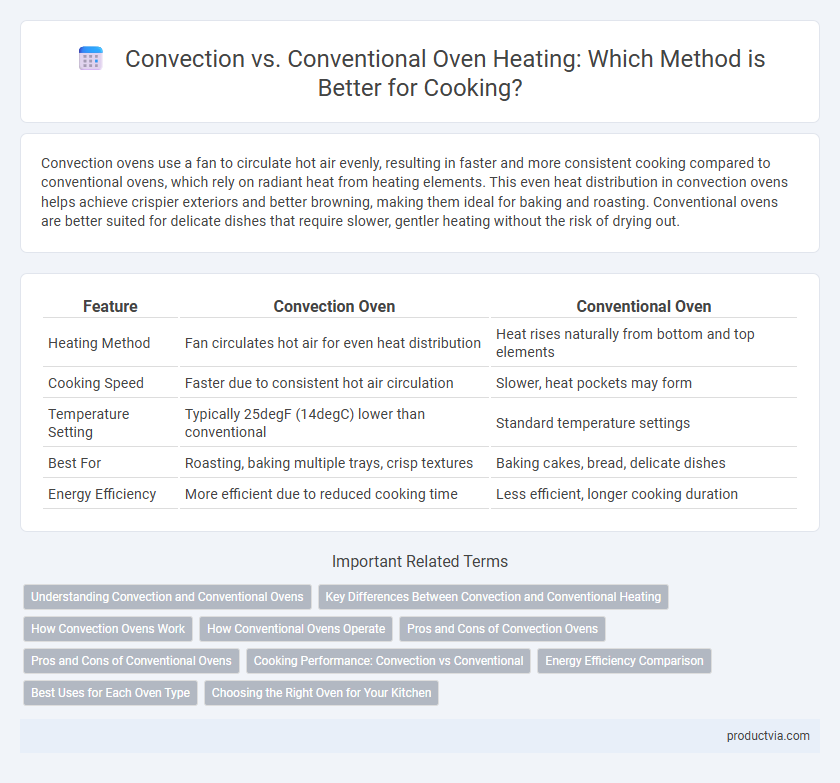Convection ovens use a fan to circulate hot air evenly, resulting in faster and more consistent cooking compared to conventional ovens, which rely on radiant heat from heating elements. This even heat distribution in convection ovens helps achieve crispier exteriors and better browning, making them ideal for baking and roasting. Conventional ovens are better suited for delicate dishes that require slower, gentler heating without the risk of drying out.
Table of Comparison
| Feature | Convection Oven | Conventional Oven |
|---|---|---|
| Heating Method | Fan circulates hot air for even heat distribution | Heat rises naturally from bottom and top elements |
| Cooking Speed | Faster due to consistent hot air circulation | Slower, heat pockets may form |
| Temperature Setting | Typically 25degF (14degC) lower than conventional | Standard temperature settings |
| Best For | Roasting, baking multiple trays, crisp textures | Baking cakes, bread, delicate dishes |
| Energy Efficiency | More efficient due to reduced cooking time | Less efficient, longer cooking duration |
Understanding Convection and Conventional Ovens
Convection ovens use a fan and exhaust system to circulate hot air evenly around the food, resulting in faster and more uniform cooking compared to conventional ovens, which rely on radiant heat from the top and bottom elements. Conventional ovens often create hot spots and longer cooking times due to uneven heat distribution. Understanding the airflow mechanism in convection ovens helps optimize baking and roasting by maintaining consistent temperatures and reducing cooking duration.
Key Differences Between Convection and Conventional Heating
Convection ovens use a fan and exhaust system to circulate hot air evenly around the food, resulting in faster and more uniform cooking compared to conventional ovens that rely on radiant heat from the top and bottom elements. This even heat distribution in convection ovens reduces cooking time by up to 25% and improves browning and crispiness, while conventional ovens may cause uneven cooking or hot spots. Convection baking is ideal for roasting meats and baking pastries, whereas conventional ovens are preferred for delicate dishes requiring gentle heat like custards and souffles.
How Convection Ovens Work
Convection ovens use a fan and exhaust system to circulate hot air evenly around the food, promoting faster and more consistent cooking. This air movement reduces hot and cold spots, allowing heat to penetrate food more efficiently compared to conventional ovens. As a result, convection ovens often cook food at lower temperatures and in less time while producing crispier textures and browned surfaces.
How Conventional Ovens Operate
Conventional ovens operate by using two heating elements, one at the top and one at the bottom, to transfer heat through natural convection and radiation. This method results in uneven heat distribution, often causing hot spots and requiring longer cooking times compared to convection ovens. Conventional ovens are ideal for baking recipes that need gradual, even cooking without the intensity of fan-driven air circulation.
Pros and Cons of Convection Ovens
Convection ovens utilize a fan to circulate hot air, resulting in faster and more even cooking compared to conventional ovens that rely on radiant heat. Pros of convection ovens include reduced cooking times, energy efficiency, and consistent browning, making them ideal for baking and roasting. However, convection ovens may require recipe adjustments due to increased heat distribution, and delicate foods can dry out if not closely monitored.
Pros and Cons of Conventional Ovens
Conventional ovens use radiant heat from the top and bottom elements, providing consistent temperature ideal for baking and roasting, but they often result in uneven cooking due to hot and cold spots. This heating method is generally more energy-efficient for simple recipes and produces moist and tender results, especially in baked goods. However, conventional ovens typically require longer cooking times and frequent rotation of dishes to ensure even browning and doneness.
Cooking Performance: Convection vs Conventional
Convection ovens use a fan to circulate hot air, ensuring even cooking and faster heat distribution compared to conventional ovens, which rely on radiant heat from fixed heating elements. This airflow reduces cooking time and enhances browning and crispiness, making convection ideal for roasting and baking. Conventional ovens provide a gentler heat, suited for slow cooking and recipes requiring steady, uniform temperatures without air movement.
Energy Efficiency Comparison
Convection ovens use a fan to circulate hot air, promoting faster and more even cooking, which results in lower energy consumption compared to conventional ovens that rely on radiant heat. Studies show convection ovens can reduce cooking time by up to 25%, significantly improving energy efficiency. Conventional ovens typically use more energy due to longer preheating and cooking times, making convection technology the preferred choice for energy-conscious consumers.
Best Uses for Each Oven Type
Convection ovens use fans to circulate hot air, ensuring even cooking and faster bake times, making them ideal for roasting meats, baking pastries, and dehydrating foods. Conventional ovens rely on radiant heat from the top and bottom elements, providing a more gentle cooking environment, perfect for casseroles, bread baking, and slow-cooking recipes. Choosing between convection and conventional depends on the specific dish's requirements for heat distribution, cooking speed, and desired texture.
Choosing the Right Oven for Your Kitchen
Convection ovens use a fan to circulate hot air, ensuring even cooking and faster baking, while conventional ovens rely on radiant heat from the top and bottom elements, which can create hot spots. Choosing the right oven depends on your cooking style: convection ovens are ideal for roasting and baking multiple trays simultaneously, whereas conventional ovens excel at traditional baking and slow cooking. Consider factors such as cooking speed, energy efficiency, and the type of meals you prepare most often when selecting between convection and conventional ovens for your kitchen.
Convection vs Conventional for Oven Heating Infographic

 productvia.com
productvia.com